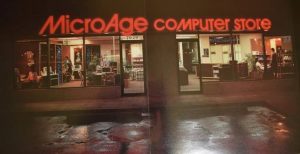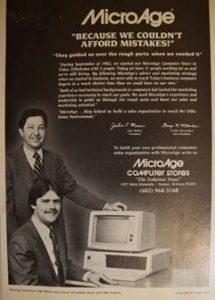George and I moved to Tulsa in June 1982 and opened Woodland store at 71st and Memorial in September 1982. We formed a corporation as The Computer Professionals Inc with me owning two-thirds of the stock and my Partner, George, having one-third. We were well-capitalized as I had cashed in my Halliburton profit sharing and George and I both sold our houses for more capital. We definitely went “all-in.”
MicroAge [the Franchisor} planned and claimed the market position of being “The Solution Store.” This matched with our experiences and talents all the way around with George and me both having technical backgrounds. MicroAge was on the leading edge of finding software and methods to live up to The Solution Store claim.
The proformas we made, along with great franchisor support, proved to be invaluable. Charlie and Riki Redfern, the Marketing team working for our Franchisor, spent a week in our store interviewing newspapers, radio and TV stations. They “beat up the media” based on our budgets and got us great deals on advertising and promotional content. Approximately 18 stores were older than ours. They were all extremely disgruntled and would hardly speak with the Franchisor who was in Chapter 11 Bankruptcy and not fulfilling promises made in the stores’ Franchise Agreements.
Because we listened and sthe older Franchisees did not, the MicroAge Franchisor decided to use our store in their national advertising. They came to our store to take photographs in our store. They even hired models to be in the photos.

They took pictures of me and George to run in the ads. They eventually ran franchise recruiting ads with our picture in it 18 times in the Wall Street Journal and full page in INC and BYTE Magazines. Our store became the “Flagship store” that set the example for the entire network.

Advancements in PC technology were happening every day at an explosive rate. When it was first introduced, an IBM PC came with 64Kb (Kb, not Mb) of memory. It had a single 5 ¼” floppy drive and usually came with a green screen monitor. It cost around $3,000. It also came with Microsoft MS-DOS which had a limit of 8-character file names. It had an Intel 8086 16-bit processor. There were two main software applications, VISICALC and Microsoft Word.
Initial “Ramp-Up”
-
- Sales volume in our first month of September 1982 was around $14,000
- Sales volume in second month of October 1982 was around $28,000. We were approved for IBM PC dealership.
- Orders for IBM PCs had to be placed three months in advance of deliveries. Prior to this, Computerland was exclusive in their IBM approval and they had a reputation for treating customers that way. The Monday after running our first ad featuring IBM PCs ran in the Sunday newspaper, the phone started to ring from corporate customers inquiring into our [non-existent] Volume Purchase Agreement.
- Sales volume in November was $40,000. We sold first Altos “multi-user” database system (MPM OS). One of my sales guys, Duke, sold this system. I remember him saying “I had a good month today.”
- We had sales of almost $100,000 in December after receiving our first shipment of IBM PCs. We had forecast three employees but we had nine by that time. We sold over 300 Commodore 64 computers along with 8 or 10 IBM PCs as systems.
- By the summer of 1983 we had our first month with over $300,000 in sales, mainly on the strength of corporate customers. We had around 15 employees by this time. This store would continue with sales of around $300,000 per month until the end of 1984.
- The accounting system, which was promised in our Franchise Agreement, could not keep up with our transactions. Invoices were hand-written then re-entered into the accounting software. There was no Point of Sale function. The system was consistently behind and we could not use it for business analysis or forecasting.
<//ul>
We had a crash course on the importance of Capital, Planning and taking advice when we needed it. Lessons learned during our ramp-up:
-
-
- Learn to use a spreadsheet program! We could not have succeeded without VISICALC for proformas and budgets and the IBM PC I had bought to run it.
- Listen to ALL advisors – Including the Franchisor’s team as well as Professionals like an Accountant and Lawyer.
- Stay open to ideas and learn the latest technologies.
- Hire new employees to cover missing talents.
- Make changes slowly, not many things at once but seize opportunities as they appear
-
We celebrated our December success by having our company sponsor a dinner for all the employees and their families. We all went to a Japanese restaurant where the cooks actually performed while cooking at the tables where we were seated. I believe this was the most fun I have ever had in a restaurant. I think it was enjoyed by all.
This was really a wild time in the new Personal Computer Industry. In sharp contrast with Apple, IBM offered documentation on the PC hardware, making it a great platform for third party integration and development. The same also held true for Microsoft DOS. When first introduced, the IBM PC did not have a hard disk. The XP model did and was introduced in the spring of 1983. With a capacity of only 10 Mb, it drove the market to bring automation into many offices. It also drove the sales for many more IBM PCs.
The IBM PC dominated the market mainly on the strength of business applications that flourished. One of the most notable of these was Lotus 123, a spreadsheet with greatly expanded capabilities over VISICALC. Another hot product was the Hewlett-Packard Laserjet. It was really big, bulky and expensive but it was a breakthrough in printing technology.
We established a track record of selling a lot of IBM PCs. Other MicroAge stores were ordering 3 or 4 PCs per month on their first orders. I ordered 8 to 10 a month during this time. When we were doing a bigger business in the summer of 1983, I was ordering 25-30 PCs a month. My dad had given me a check writing machine that embossed checks. It would emboss checks in amounts to $99,999.99. I remember times when I had to write two checks to IBM because the bills were larger than the embosser could make. Eventually, there was a shortage of PCs and IBM put them on allocation. Because of our track record, we were able to get PCs when the other stores could not.
